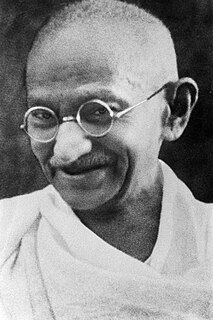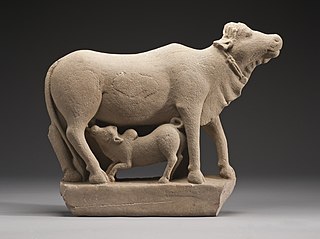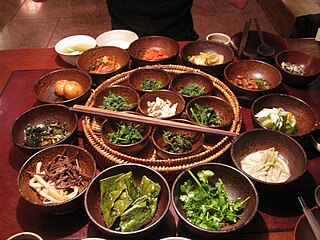
Ahimsa is an ancient Indian principle of nonviolence which applies to all living beings. It is a key virtue in Hinduism, Buddhism and Jainism.

Buddhist cuisine is an Asian cuisine that is followed by monks and many believers from areas historically influenced by Chinese Buddhism. It is vegetarian or vegan, and it is based on the Dharmic concept of ahimsa (non-violence). Vegetarianism is common in other Dharmic faiths such as Hinduism, Jainism and Sikhism, as well as East Asian religions like Taoism. While monks and a minority of believers are vegetarian year-round, many believers follow the Buddhist vegetarian diet for celebrations.

Jainism, traditionally known as Jain Dharma, is an ancient Indian religion. Followers of Jainism are called "Jains", a word derived from the Prakrit word jina, meaning "victor". Jains trace their spiritual ideas and history through a succession of twenty-four leaders or tirthankaras, with the first being Rishabhanatha, who according to Jain tradition lived millions of years ago, the twenty-third tirthankara Parshvanatha in 900 BCE, and the twenty-fourth tirthankara the Mahāvīra around 500 BCE. Jains believe that Jainism is an eternal dharma with the tirthankaras guiding every cycle of the Jain cosmology. Their canonical religious texts are called Agamas and Paramagamas.

The Five precepts ; or five rules of training is the most important system of morality for Buddhist lay people. They constitute the basic code of ethics to be undertaken by lay followers of Buddhism. The precepts are commitments to abstain from killing living beings, stealing, sexual misconduct, lying and intoxication. Within the Buddhist doctrine, they are meant to develop mind and character to make progress on the path to enlightenment. They are sometimes referred to as the Śrāvakayāna precepts in the Mahāyāna tradition, contrasting them with the bodhisattva precepts. The five precepts form the basis of several parts of Buddhist doctrine, both lay and monastic. With regard to their fundamental role in Buddhist ethics, they have been compared with the ten commandments in Abrahamic religions or the ethical codes of Confucianism. The precepts have been connected with utilitarianist, deontological and virtue approaches to ethics, though by 2017, such categorization by western terminology had mostly been abandoned by scholars. The precepts have been compared with human rights because of their universal nature, and some scholars argue they can complement the concept of human rights.
Ātman is a Sanskrit word that means inner self, spirit, or soul. In Hindu philosophy, especially in the Vedanta school of Hinduism, Ātman is the first principle, the true self of an individual beyond identification with phenomena, the essence of an individual. In order to attain Moksha (liberation), a human being must acquire self-knowledge. For the different schools of thought, self-realization is that one's true self (Jīvātman) and the ultimate reality (Brahman) are: completely identical, completely different, or simultaneously non-different and different.

Nonviolence is the personal practice of being harmless to one's self and others under every condition. It comes from the belief that hurting people, animals and/or the environment is unnecessary to achieve an outcome and it also refers to a general philosophy of abstention from violence. This may be based on moral, religious or spiritual principles, or the reasons for it may be purely strategic or pragmatic.

Indian philosophy refers to philosophical traditions of the Indian subcontinent. A traditional classification divides orthodox (āstika) and heterodox (nāstika) schools of philosophy, depending on one of three alternate criteria: whether it believes the Vedas as a valid source of knowledge; whether the school believes in the premises of Brahman and Atman; and whether the school believes in afterlife and Devas.

Due to the multiple benefits from cattle, there are varying beliefs about cattle in societies and religions. In some regions, especially Nepal and most states of India, the slaughter of cattle is prohibited and their meat may be taboo.

A lacto-vegetarian diet is a diet that includes vegetables as well as dairy products such as milk, cheese, yogurt, butter, ghee, cream, and kefir.

The Eastern religions are the religions that originated in East, South and Southeast Asia and thus have dissimilarities with Western religions. This includes the East Asian religions, Indian religions as well as animistic indigenous religions.

Vegetarianism is strongly linked with a number of Dharmic traditions (religions) that originated in ancient India, and it is sometimes linked with non-Dharmic religions.

Śramaṇa means "one who labours, toils, or exerts themselves " or "seeker, one who performs acts of austerity, ascetic". The term in early Vedic literature is predominantly used as an epithet for the Rishis with reference to Shrama associated with the ritualistic exertion. The term in these texts doesn't express non-Vedic connotations as it does in post-Vedic Buddhist and Jain canonical texts. During its later semantic development, the term came to refer to several non-Brahmanical ascetic movements parallel to but separate from the Vedic religion. The Śramaṇa tradition includes Jainism, Buddhism, and others such as the Ājīvikas, Ajñanas and Cārvākas.
Anekāntavāda refers to the Jain doctrine about metaphysical truths that emerged in ancient India. It states that the ultimate truth and reality is complex and has multiple aspects. Anekantavada has also been interpreted to mean non-absolutism, "intellectual Ahimsa", religious pluralism, as well as a rejection of fanaticism that leads to terror attacks and mass violence. Some scholars state that modern revisionism has attempted to reinterpret anekantavada with religious tolerance, openmindedness and pluralism.

Buddhist vegetarianism is the practice of vegetarianism by significant portions of Mahayana Buddhist monks and nuns and some Buddhists of other sects. In Buddhism, the views on vegetarianism vary between different schools of thought. The Mahayana schools generally recommend a vegetarian diet because in some sutras the Buddha set forth that his followers not eat the flesh of any sentient being.

Buddhist ethics are traditionally based on what Buddhists view as the enlightened perspective of the Buddha, or other enlightened beings such as Bodhisattvas. The Indian term for ethics or morality used in Buddhism is Śīla or sīla (Pāli). Śīla in Buddhism is one of three sections of the Noble Eightfold Path, and is a code of conduct that embraces a commitment to harmony and self-restraint with the principal motivation being nonviolence, or freedom from causing harm. It has been variously described as virtue, moral discipline and precept.

The position and treatment of animals in Buddhism is important for the light it sheds on Buddhists' perception of their own relation to the natural world, on Buddhist humanitarian concerns in general, and on the relationship between Buddhist theory and Buddhist practice.

Ahinsā in Jainism is a fundamental principle forming the cornerstone of its ethics and doctrine. The term ahinsa means nonviolence, non-injury and absence of desire to harm any life forms. Vegetarianism and other nonviolent practices and rituals of Jains flow from the principle of ahimsa. The Jain concept of ahimsa is very different from the concept of nonviolence found in other philosophies. Violence is usually associated with causing harm to others. But according to the Jain philosophy, violence refers primarily to injuring one's own self – behaviour which inhibits the soul's own ability to attain moksha. At the same time it also means violence to others because it is this tendency to harm others that ultimately harms one's own soul. Furthermore, the Jains extend the concept of ahimsa not only to humans but to all animals, plants, micro-organisms and all beings having life or life potential. All life is sacred and everything has a right to live fearlessly to its maximum potential. Living beings need not fear those who have taken the vow of ahimsa. According to Jainism, protection of life, also known as abhayadānam, is the supreme charity that a person can make.
The cow protection movement is a predominantly Indian religious and political movement aiming to protect cows, whose slaughter has been broadly opposed by Hindus, Buddhists, Jains, Zoroastrian and Sikhs. While the opposition to slaughter of animals, including cows, has extensive and ancient roots in Indian history, the term refers to modern movements dating back to the colonial era British India. The earliest such activism is traceable to Sikhs of Punjab who opposed cow slaughter in the 1860s. The movement became popular in the 1880s and thereafter, attracting the support from the Arya Samaj founder Swami Dayananda Saraswati in the late 19th century, and from Mahatma Gandhi in the early 20th century.
Biocentrism, in a political and ecological sense, as well as literally, is an ethical point of view that extends inherent value to all living things. It is an understanding of how the earth works, particularly as it relates to its biosphere or biodiversity. It stands in contrast to anthropocentrism, which centers on the value of humans. The related ecocentrism extends inherent value to the whole of nature.
Lacto-Vegetarianism is an integral part of most schools of Hinduism although there is a wide variety of practices and beliefs that have changed over time because with the spiritual practices satvik food is more recommended by saints. By one estimate, 30% of all Hindus are ovo-lacto vegetarians. Most surveys, including one by the Office of Registrar General and Census Commissioner of India, show 60% to 70% or even more of Indians eat meat. Most sects of Hindus do not observe vegetarianism. Dietary habits and dietary customs were factors that have played roles in the formation, evolution and development of Indian caste system.
















